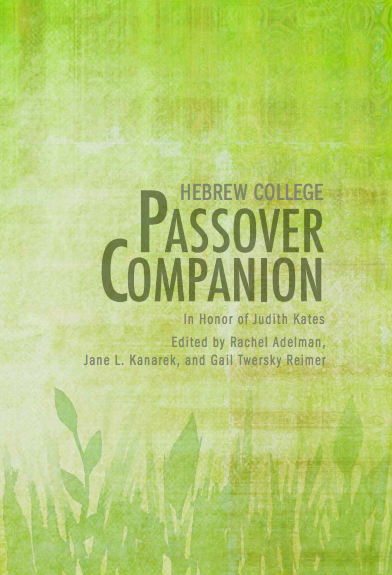“She who stood up for our ancestors and ourselves…” The surprising presence of the feminine pronoun in this sentence (which probably originally just meant: “that which transpired both for our ancestors and ourselves”) gave the mystical tradition a chance to point to the hidden divine female as the force that redeemed Israel from Egypt. This particular face of God (or “aspect of the divine unity,” if you prefer) is named binah. “She” is the deep inward place toward which we turn in contemplation. But she is also Y-H-W-H as Great Mother, the inner force of creativity, the cosmic womb out of which each new idea, design, and even moment will flow forth. She comes into our “Egypt,” mitzrayim, the narrow straits out of which our freedom needs to be born, stretches us forth in all directions, and thus guides and saves us in that birth-giving process of newness. We become mothers like Her, birthing our ideas, our teachings, our students themselves. “One who teaches another’s child Torah is like one who bore them both” (B. Kiddushin 30a). This is intellectual and spiritual parenthood, well-known to rebbes of all sorts across many generations.
The love of Mother-binah is so great, they claim, that She brings us all the way out of Egypt, ready to take us directly to the mountain, to give us the Torah all at once. An old Talmudic tradition claimed that “there are fifty measures of binah in the world, and Moses received forty-nine of them” (B. Rosh Hashanah 21b). This teaching immediately links up in the mystical imagination with both the counting of the omer and the numbering of the sabbatical (every seven years) and jubilee years (every fifty years). Moses in his wisdom saw that liberation from Egypt, given as a gift from beyond, would not be able to sustain itself. The newly expanded mind, like the recently released Hebrews of the biblical tale, would founder as soon as the first challenges arise. Therefore, even though our compassionate Mother has totally liberated us on the eve of Pesah, making “the mountains skip like rams” (Psalms 114:4), we are not allowed to dance our way to Sinai all at once. We are not ready. On the day after liberation we begin counting, working our way “up the mountain” or into the open heart, each day struggling to find our own path through the wilderness, until we are ready to receive the Torah.
But what is that Torah we receive on the fiftieth day? Isn’t that the one that even Moses couldn’t attain? Could it be that Torah is none other than binah Herself ? As we count the days of the omer, we measure out seven times seven, each of the seven lower sefirot, manifest in us as emotional qualities, combined with each of the others. Binah is the mind that contains and transcends them all. But the tradition has us moving in the other direction. We start, on the second night of Pesah, with ḥesed she-beḥesed, ultimate divine grace, the first-born quality to emerge from binah’s womb, and go toward malkhut she-bemalkhut, divinity in its most manifest form. It is only after our fifty-day journey that Torah, now identified with malkhut or shekhinah, is ready to enter the world. That will make Israel into Torah’s proper suitor, at Sinai to become God’s worthy son-in-law, the husband of His/Her daughter the Torah. We receive the deep wisdom of Mother as evolved into Bride. The incest taboo is thus avoided, but it remains clear that it is Mother who set the whole process in motion
To try to penetrate the psychospiritual meaning of this liberation by the inner Mother, we turn to a passage from the opening pages of the Zohar, the great poetic rendition of the symbolic language called Kabbalah. The teaching addresses itself to Israel, a nation scattered throughout the world, its brokenness given expression in the destroyed city of Jerusalem. “Your breach is as wide as the sea,” says the poet of Lamentations (2:13), with a metaphor of destruction that is also notably reminiscent of birth. Israel, or the Holy City, has been split wide open. She feels as though repairing that breach is impossible. Her children are scattered everywhere, seemingly never to return. “Who can heal you?” the verse goes on to say, as if no restoration is possible.
But then the Zohar works its charms. The word for “sea” in Hebrew is yam. But its two consonants, reversed, spell mi, which means “Who?” The letters mem and yod (numerically adding up to fifty) form a symbol term for binah, since She is ever mysterious, beyond knowing, that elusive fiftieth “gate.” Binah is the eternal question to which there is no answer: “Who?” The latter part of 2:13 is then taken not as a despairing question (“Who can heal you?”) but as the ultimate comforting reassurance (“the Who can heal you!”).
All of us go through moments when we feel broken beyond repair. Our own restorative powers are scattered, beyond our reach. We cannot easily “put ourselves back together again.” The exile of Israel and the destruction of Jerusalem are both powerful symbols of the human condition, the alienation from ourselves and from our Source that we all feel as we go through our daily lives, our multiple forms of “wandering through the wilderness.” But the Zohar offers an assurance that we have within ourselves a mysterious deeper resource, a part of us that has escaped this great breakage. It is the internal womb, the great Mother of healing and creativity. We learn to call her forth by the act of reversing the letters—discovering that the great breakage is itself the great healing, that the moment of confronting despair is also that of turning toward that deeper source, to find redemption there.
She, the broken heart within you, is also the heart that heals. That is how we come out of Egypt, over and over again.



